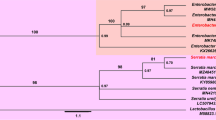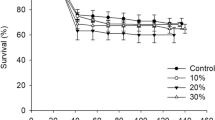Abstract
The effects of organic nitrogen, nitrate, phosphorus, potassium and water content of leaves of intact maize plants, grown in a gravel culture system, on the fitness of the African armyworm, Spodoptera exempta (Walker)(Lepidoptera: Noctuidae) were studied. Organic nitrogen concentrations ranged from 1.3% to 3.7% over four treatments differing only in nitrate supply to the plants. Water content and other mineral levels were all positively correlated with the organic nitrogen level. Feeding damage by the caterpillars was most severe on the lowest nitrate treatments, where it could be least well compensated for by new leaf growth. Larval and pupal fitness variables were not affected by treatment, except for larval development on the lowest nitrate treatment which was delayed by just 1 day. The large compensatory capacity of the larvae was underlined by a similar mineral composition of the pupae in all treatments. Adult fitness variables hardly differed between the upper three nitrate treatments, but revealed a trend over all treatments: the higher the organic nitrogen content of the leaves, the shorter the pre-oviposition period and the higher the fecundity. This trend, however, might have been due to differences in available food quantity rather than in food quality. It is concluded that fitness of the African armyworm is only slightly affected over a wide range of nitrogen concentrations in its food. Though effects might be larger under field conditions, the large differences in outbreak development between years seem not to be attributable to observed differences in nitrogen levels in host plants between years in primary outbreak areas. Other environmental factors appear to be of greater importance.
Similar content being viewed by others
References
Brown ES (1962) The African army worm Spodoptera exempta (Walker) (Lepidoptera, Noctuidae): a review of the literature. Commonwealth Institute of Entomology, London
Brown ES, Swaine G (1966) New evidence on the migration of moths of the African armyworm, Spodoptera exempta (Walker) (Lepidoptera, Noctuidae). Bull Entomol Res 56: 671–684
Dewhurst CF (1985) The African armyworm (Spodoptera exempta) the East African story outlined from 1962. Antenna 9: 12–18
Faure JC (1943) Phase variation in the armyworm, Laphygma exempta (Walker), Union S Afr Dep Agric For Sci Bull 234
Graham JF (1971) Armyworm outbreak in 1961. FAO Plant Prot Bull 9: 182–184
Gunn A, Gatehouse AG (1985) Effects of the availability of food and water on reproduction in the African armyworm, Spodoptera exempta. Physiol Entomol 10: 53–63
Gunn A, Gatehouse AG, Woodrow KP (1988) Trade-off between flight and reproduction in the African armyworm moth, Spodoptera exempta. Physiol Entomol 14: 419–427
Haggis MJ (1986) Distribution of the African armyworm, Spodoptera exempta (Walker)(Lepidoptera: Noctuidae), and frequency of larval outbreaks in Africa and Arabia. Bull Entomol Res 76: 151–170
Hanway JJ (1962) Corn growth and composition in relation to soil fertility. III. Percentages of N, P and K in different plant parts in relation to stage of growth. Agron J 54: 222–229
Hattingh CC (1941) The biology and ecology of the army worm (Laphygma exempta) and its control in South Africa. Union S Afr Dep Agric For Sci Bull 217
Haukioja E, Hakala T (1975) Herbivore cycles and periodic out-breaks. Formulation of a general hypothesis. Rep Kevo Subarct Res Stn 12: 1–9
Huffaker RC, Rains DW (1978) Factors influencing nitrate acquisition by plants: assimilation and fate of reduced nitrogen. In: Nielsen DR, MacDonald JG (eds) Nitrogen in the environment, vol 2. Soil-plant-nitrogen relationships. Academic Press, New York, pp 1–43
Janssen JAM (1993) African armyworm outbreaks: why do they occur after drought? PhD thesis. Wageningen Agricultural University, The Netherlands
Janssen JAM (1993a) Soil nutrient availability in relation to drought intensity and outbreak development of Spodoptera exempta in Kenya. Bull Entomol Res (in press)
Janssen JAM (1993b) Effects of the mineral composition and water content of excised leaf sections on the fitness of the African armyworm. Entomol Exp Appl (in press)
Janssen JAM, Rose DJW (1990) Does the nutritional quality of the larval host plants influence the occurrence of outbreaks of the African armyworm? Meded Fac Landbouwwet Rijksuniv Gent 55: 289–295
Johnson CG (1969) Migration and dispersal of insects by flight. Methuen, London
Karowe DN, Martin MM (1989) The effects of quantity and quality of diet nitrogen on the growth, efficiency of food utilization, nitrogen budget, and metabolic rate of fifth instar Spodoptera eridania larvae (Lepidoptera: Noctuidae). J Insect Physiol 35: 699–708
Levy R, Cromroy HL (1973) Concentration of some major and trace elements in forty-one species of adult and immature insects determined by atomic absorption spectroscopy. Ann Entomol Soc Am 66: 523–526
Loader C, Damman H (1991) Nitrogen content of food plants and vulnerability of Pieris rapae to natural enemies. Ecology 72: 1586–1590
Manuwoto S, Scriber JM (1985) Differential effects of nitrogen fertilization of three corn genotypes on biomass and nitrogen utilization by the southern armyworm, Spodoptera eridania. Agric Ecosyst Environ 14: 25–40
Matthee JJ (1946) A study of the phases of the army worm (Laphygma exempta Walker). J Entomol Soc S Afr 9: 60–77
Mattson WJ, Scriber JM (1987) Nutritional ecology of insect folivores of woody plants: nitrogen, water, fiber and mineral considerations. In: Slansky F, Rodriguez JG (eds) Nutritional ecology of insects, mites, spiders, and related invertebrates. Wiley, New York, pp 147–175
McDonald G, Cole PG (1991) Factors influencing oocyte development in Mythimna convecta (Lepidoptera: Noctuidae) and their possible impact on migration in eastern Australia. Bull Entomol Res 81: 175–184
Novozamsky I, Houba VJG, Eck R van, Vark W van (1983) A novel digestion technique for multi-element plant analysis. Commun Soil Sci Plant Anal 14: 239–248
Odiyo PO (1979) Forecasting infestations of a migrant pest: the African armyworm Spodoptera exempta (Walker). Philos Trans R Soc Lond B 287: 403–413
Price PW, Bonton CE, Gross P, McPheron BA, Thompson JN, Weis AE (1980) Interactions among three trophic levels: influence of plants on interactions between insect herbivores and natural enemies. Annu Rev Ecol Syst 11: 41–65
Rhoades DF (1983) Herbivore population dynamics and plant chemistry. In: Denno RF, McClure MS (eds) Variable plants and herbivores in natural and managed systems. Academic Press, New York, pp 155–220
Rhoades DF (1985) Offensive-defensive interactions between herbivores and plants: their relevance in herbivore population dynamics and ecological theory. Am Nat 125: 205–238
Risch SJ (1987) Agricultural ecology and insect outbreaks. In: Barbosa P, Schultz JC (eds) Insect outbreaks. Academic Press, San Diego, pp 217–238
Rose DJW, Dewhurst CF (1979) The African armyworm, Spodoptera exempta: congregation of moths in trees before flight. Entomol Exp Appl 26: 346–348
Scriber JM (1978) Cyanogenic glycosides in Lotus corniculatus. Their effect upon growth, energy budget, and nitrogen utilization of the southern armyworm, Spodoptera eridania. Oecologia 34: 143–155
Scriber JM, Feeny P (1979) Growth of herbivorous caterpillars in relation to feeding specialization and to the growth form of their food plants. Ecology 60: 829–850
Simpson SJ, Abisgold JD (1985) Compensation by locusts for changes in dietary nutrients: behavioural mechanisms. Physiol Entomol 10: 443–452
Simpson SJ, Simpson CL (1990) The mechanisms of nutritional compensation by phytophagous insects. In: Bernays EA (ed) Insect-plant Interactions, vol 2. CRC Press, Boca Raton, pp 111–160
Slansky F, Feeny PP (1977) Stabilization of the rate of nitrogen accumulation by larvae of the cabbage butterfly on wild and cultivated food plants. Ecol Monogr 47: 209–228
Sokal RR, Rohlf FJ (1981) Biometry. Freeman, New York
Steer BT (1982) Nitrogen and nitrate accumulation in species having different relationships between nitrate uptake and reduction. Ann Bot 49: 191–198
Terman GL, Noggle JC, Hunt CM (1976) Nitrate-N and total N concentration relationships in several plant species. Agron J 68: 556–660
Tucker MR (1984) Forecasting the severity of armyworm seasons in East Africa from early season rainfall. Insect Sci Appl 5: 51–55
White TCR (1969) An index to measure weather-induced stress of trees associated with outbreaks of psyllids in Australia. Ecology 50: 905–909
White TCR (1974) A hypothesis to explain outbreaks of looper caterpillars, with special reference to populations of Selidosema suavis in a plantation of Pinus radiata in New Zealand. Oecologia 16: 279–301
White TCR (1976) Weather, food and plagues of locusts. Oecologia 22: 119–134
White TCR (1984) The abundance of invertebrate herbivores in relation to the availability of nitrogen in stressed food plants. Oecologia 63: 90–105
Woodrow KP, Gatehouse AG, Davies DA (1987) The effect of larval phase on flight performance of African armyworm moths, Spodoptera exempta (Walker)(Lepidoptera: Noctuidae). Bull Entomol Res 77: 113–122
Author information
Authors and Affiliations
Rights and permissions
About this article
Cite this article
Janssen, J.A.M. Effects of the mineral composition and water content of intact plants on the fitness of the African armyworm. Oecologia 95, 401–409 (1993). https://doi.org/10.1007/BF00320995
Received:
Accepted:
Issue Date:
DOI: https://doi.org/10.1007/BF00320995




